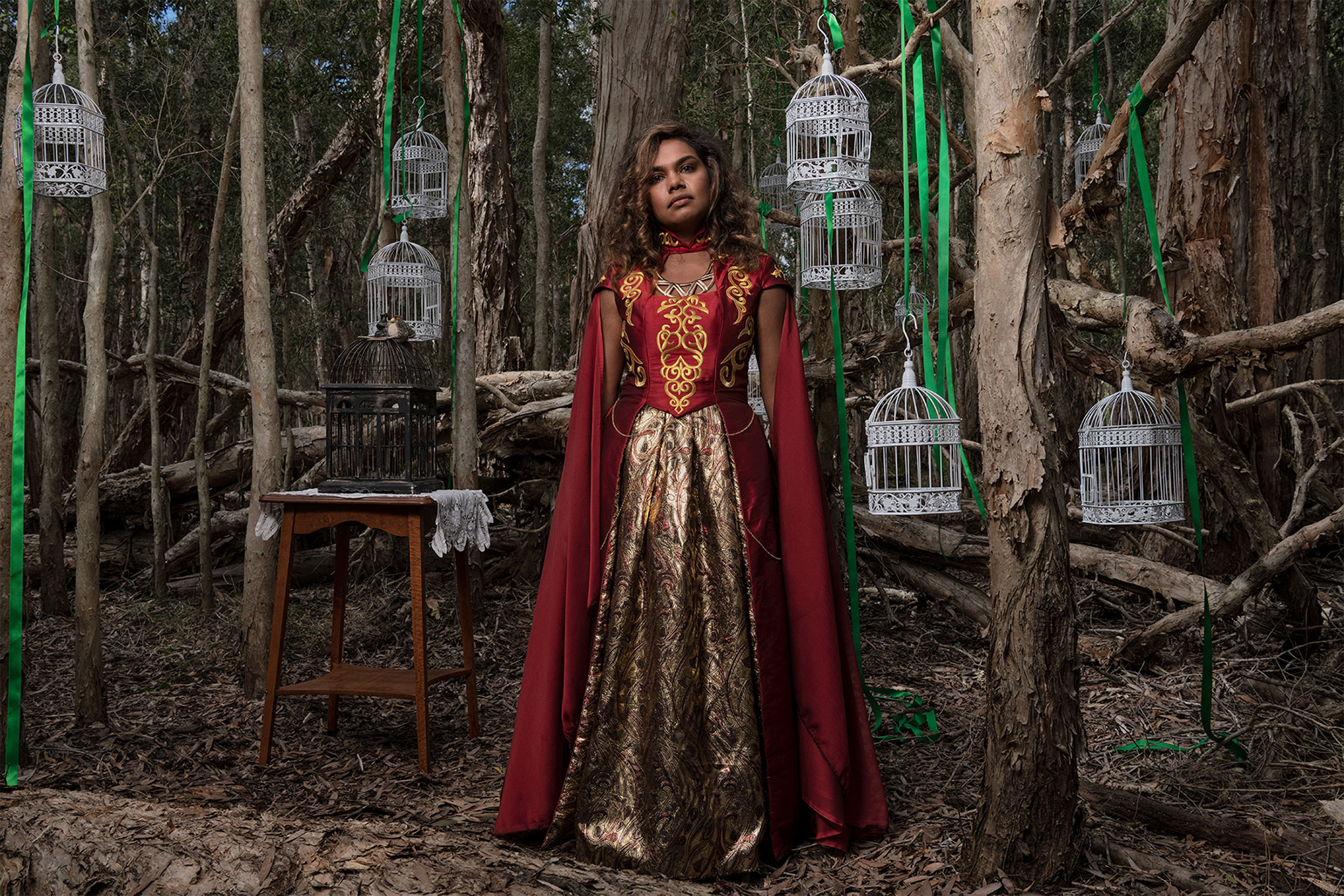Audio descriptions: Artworks in the exhibition Fiona Foley: Veiled Paradise.

Fiona Foley, The Magna Carta Tree #2, 2021, inkjet print, 80 x 120 cm. Courtesy the artist and Andrew Baker Art Dealer, Brisbane. Photo: Mick Richards.
Fiona Foley, The Magna Carta Tree two, 2021.
This is the second photograph in a series of seventeen. The photograph is an inkjet print on paper and 80 centimetres high by 120 centimetres wide, and it’s in a frame that measures 1 metre high and 150 centimetres wide. The frame is white, and the image is sitting on white board within the frame.
In the centre of the image is a young Aboriginal woman standing amongst a dense forest of paperbark trees and wearing a regal red and gold gown. It is daylight with glimpses of blue sky between the trees in the background and limited sunlight showing through, making the scene quiet dark.
The figure is looking directly at us, her lips together and head titled slightly to her right-hand side, her hair is brown, just below her shoulders and in tightly curled locks. Her dress has a red bodice with a scooped neckline and neck collar and adorned with detailed gold embroidery. Long red sleeves drape down either side of her arms to the ground. The base of her dress is slightly shaped outwards, with the red from the bodice framing a central gold coloured panel, that has a swirling red pattern, and covers her feet. The fabric looks like a shiny satin and the light is catching it.
The ground is flat and coated in primarily brown leaf litter and sticks. The paperbark trees have long, straight, and thin trunks, and in the background, there are some fallen or sloping trees and small, dark green leaves. The tops of the trees cannot be seen. Hanging from the trees are eight ornate white bird cages, which are domed at the top. They hang at varying heights mostly in the foreground, but some back amongst the trees. Each cage is closed and empty, and suspended by bright and thick green ribbon, with the ribbon trails hanging down along the ground.
To your left and the figure’s right there is a small square wooden table that is slightly higher than a coffee table. It is brown with angled legs and a delicate lace runner hanging off the sides. On top is a black cage, which is just larger than the white ones, it’s base is square and the top is domed. It is also closed and empty. On top of the black cage sits a fluffy toy bird with grey and brown feathers and a yellow beak.
The Magna Carta Tree is a new series of photographic works shot on Badtjala Country. The series examines a mangrove tree named by cattle farmer, Lindsay Titmarsh, on whose property—Tandora—the tree has been living for over 700 years. The farmer named the tree after the Magna Carta—which was underwritten in 1215. It is about the same age as the tree on the farmer’s property. The Magna Carta is an infamous charter that has led much of Western law since its inception. The 39th Clause of the Magna Carta states:
"No free man shall be seized or imprisoned, or stripped of his rights or possessions, or outlawed or exiled, or deprived of his standing in any other way, nor will we proceed with force against him, or send others to do so, except by the lawful judgement of his equals or by the law of the land. To no one will we sell, to no one deny or delay right or justice."
The series creates its own rich and swirling narratives around the history of the pirri (mangrove tree in Badtjala language). In Foley’s wry style, the series references invasion, the contradictions inherent in law, and the ownership of land, all the while celebrating the rich cultural heritage of the Badtjala people and the land with which they are and have been connected to for millennia.

